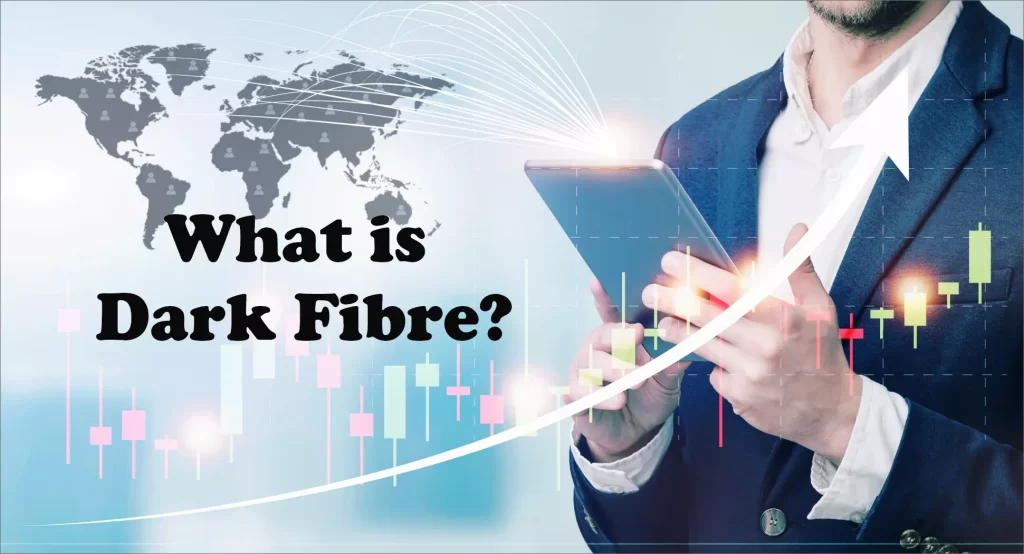What Is Dark Fibre? How Does It Work

Data is necessary for all businesses and has become a priority now. We can say that reliable data centers and high bandwidth have become the primary needs of current businesses. Dark Fiber is an excellent and secure solution to meet this demand of businesses.
This FiberFiber is also known as unlit Fiber and is a fiber optic cable laid underground, but it does not have any service or traffic. It is usually used for network communication and telecom. Dark Fiber has become increasingly significant due to increased reliable, secure, and high-speed data transmission.
In this article, we will describe everything you need to know about dark FiberFiber and help you understand why you should use it for your business.
What Is Dark Fibre?
Dark Fiber or unlit Fiber are fiber optic cables laid underground but remain unused. Fiber optic cables are thin, flexible strands of glass or plastic that transmit data in light pulses. Since no information is passed through these cables, there is no light; thus, it is called dark Fiber.
Today, businesses and institutions use these unused fiber optic cables on lease for network communications. Even after they come in use, they are called dark fibers because they work independently from other network cables. When these unlit fiber cables are laid, most companies assign higher costs. However, it helps reduce future labor costs when a massive surge in traffic occurs. These fibers form the backbone of modern telecommunications, allowing the transmission of vast amounts of data over long distances at an incredible speed.
Furthermore, the progress in data packaging techniques has resulted in optical fiber networks often having surplus capacity. These circumstances create an opportunity to develop and utilize operational dark fibers.
How Does Dark Fibre Work?
Dark Fiber allows businesses to have autonomy over their private communication highway and helps them optimize and make essential decisions about critical elements of their network. You only need to buy or lease fiber optic cables from a network provider and use them to build point-to-point connections for your business using on-site transmission equipment. Part of the agreement is that you are responsible for managing, lighting, and maintaining the fiber optic network, not your service provider.
So, suppose you want to have a dedicated network or dark fiber network for your business. In that case, it is essential to have an internal network team to create business-specific protocols and maintain your system.
Typically, dark fibers are leased in pairs such as two, four, or eight strands from a fiber optic cable of 144 to 432 strands. Renting pairs of dark FiberFiber enables two-way communication between two points.
In a dark fiber pair, one Fiber is assigned to sending data, and the other is dedicated to receiving data. Upon securing access to dark Fiber, an organization can activate it by deploying its optical equipment at both ends. It involves employing transmitters to convert electrical signals into optical signals for transmission and receivers to convert received optical signals back into electrical signals.
Dark Fiber Vs. Lit Fibre
The main difference between dark and lit Fiber is in the service, equipment, capacity, control, cost, configuration, and privacy that they offer.
Let’s have a look at these two types of cables to understand the difference between them:
1. Dark Fiber
As we described above, it is unlit, unused, or inactive optical fiber cables that are installed but currently not transmitting data. They are called “dark” because they don’t have light signals to transmit data over fiber optic cables.
Businesses use these cables to create their private network, giving them control over data transmission speed, capacity, and security.
2. Lit Fiber
These active fiber optic cables currently transmit data. They are called “lit” because they have light signals to transmit data.
The bandwidth of a lit fiber network is typically shared between multiple users, and a service provider manages this network.
What Are The Benefits Of Dark Fibre?
When your business has its fiber optic network, you can benefit from optimizing business operations for incredible network speed. Dark Fiber can reduce inefficiencies and improve effectiveness, allowing you to fulfill your business-specific needs, and it is very beneficial, especially if you are part of a fast-growing industry.
Moreover, it is more economical in the long run and allows businesses to run their network independently without any external contractor.
Now, let’s look at the benefits of dark Fiber.
i. Increased Security
In the era of GDPR, cyber threats, and progressively sophisticated scams, safeguarding the security of a company’s systems, networks, and infrastructure is essential.
It is particularly crucial given that, based on research from the UK Government’s Cyber Security Breaches Survey in 2022, 39% of businesses in the UK experienced a cyber-attack, with 31% reporting attacks occurring at least once a week.
Given statistics of this nature, prioritizing security becomes paramount, especially when handling sensitive information that criminals could exploit to harm or steal from customers or users. Dark Fiber presents a cutting-edge solution to this challenge by providing access to dedicated, entirely private, unshared cables.
It ensures that your network remains inaccessible to everyone, including customers, competitors, and potential criminals — preventing unauthorized recording or monitoring of your data. This additional layer of security can be a decisive factor in safeguarding sensitive information.
ii. Control Over Capacity And Scale
Your business’s operational efficiency and success hinge on having comprehensive control over the capacity and scalability of its communication network. Fiber-optic cables enable DWDM (Dense Wavelength Division Multiplexing), dividing the fibers into individualized wavelengths across the spectrum. It permits more data signals and enhances the system’s capacity for handling multiple data streams.
The limitless possibilities allow you to determine which systems or services can access them without compromising network speed or capability. A straightforward upgrade to your on-site transmission equipment is also required to increase your capacity.
This feature can be particularly advantageous for start-ups or smaller companies experiencing rapid growth, enabling them to expand and tailor their bandwidth to their size, operations, and the evolving needs of their customers.
iii. Unlimited Scalability
Dark Fiber offers limitless potential, requiring only routine maintenance of transmission equipment and occasional upgrades to reduce latency and enhance a network’s bandwidth.
By eliminating dependence on service providers, changes can be implemented effectively and efficiently, precisely when needed for your business.
This autonomy grants you the authority to determine the timing and extent of investments in equipment upgrades, minimizing the necessity for unnecessary network-related acquisitions, as your bandwidth remains adaptable to scale at all times.
iv. Security
Dark Fiber can enhance network security by providing a dedicated and private communication channel. Since the fibers are unused, there’s less risk of interference or interception of data.
v. Cost-Efficiency
In some cases, leasing dark FiberFiber can be more cost-effective than deploying and maintaining an entirely new network.
It is especially true for businesses with varying bandwidth needs who want to avoid the costs associated with overbuilding.
vi. Reliability
Dedicated Internet offers a leased line with dark FiberFiber, allowing you to manage essential repairs and maintenance independently. This approach ensures your business maintains a dependable, high-speed, and secure connection.
In contrast to traditional networks, where you must inform your network provider to send a technician in case of issues, dark fiber ownership empowers you to address equipment concerns with your in-house IT technicians.
This capability facilitates efficient downtime management, preventing significant business losses and enabling cost savings.
Disadvantages Of Dark Fibre
Along with the advantages, there are some disadvantages of dark Fiber that you must have in your mind.
i. Upfront Investment
The first step before establishing a dark fiber connection between your database is setting up a link between your location and a network provider.
Following this, the next step involves procuring and installing the necessary equipment for data transmission over the network.
While the initial cost for this setup may be higher than traditional ISPs, it lays the foundation for enhanced control and dedicated connectivity.
ii. Maintenance
At this juncture, it is evident that leasing a dark fiber line comes with numerous advantages. However, the maintenance aspect introduces a different set of challenges.
It is imperative to guarantee that your technicians can effectively manage the network, especially in fiber cuts and routing issues.
iii. Availability
Dark Fiber is not available in all areas, so it is essential to ensure that your service provider offers it in your area before leasing a dark fiber.
What Are The Uses Of Dark Fibre?
The data in dark fiber and other optical fibers is transmitted simultaneously. Still, the data in the dark fibers remain separated from the regular data. It is appended by transmitting them at different wavelengths.
Furthermore, it is possible to convert one fiber optic cable into multiple fiber optic cables, and this process is known as Dense Wavelength Division Multiplexing (DWDM), which helps businesses to have a secure network with an unmatched performance level.
Businesses that require high bandwidth and a secure network must have a private network like a dark fiber network. This isolation helps protect sensitive information and allows you to control your network.
Businesses that can take the most out of dark Fiber include:
- E-commerce platforms
- Banks
- Service-based companies
- Government institutions
- Schools and colleges
- Offices
- Product-based businesses
Final Words - Dark Fiber
In conclusion, dark Fiber represents a transformative solution in data transmission and network infrastructure. As businesses increasingly prioritize reliable, secure, high-speed data communication, dark Fiber emerges as a key player in meeting these demands. Its advantages, including increased security, control over capacity and scalability, unlimited scalability, and cost-efficiency, make it an attractive option for businesses looking to optimize their network operations. Despite the upfront investment and maintenance challenges, the benefits of dark FiberFiber, such as autonomy, reliability, and enhanced security, position it as a valuable asset for industries ranging from e-commerce and banking to government institutions and educational facilities. The ability to control, secure, and scale your network independently makes Dark Fiber a forward-looking choice in the ever-evolving landscape of modern business communication.
“Dark” in dark Fiber signifies that the optical fibers are inactive and do not carry data signals. It is like a “dark” or unused resource awaiting activation.
Lit Fiber actively transmits data signals, typically managed by a service provider. In contrast, dark Fiber is not in use and allows users to control and manage their data transmission equipment and protocols.
Dark Fiber offers greater control, scalability, and flexibility for organizations. Users can deploy their equipment, control bandwidth, and easily upgrade their network infrastructure without relying on a third-party service provider.
Dark FiberFiber can be leased from telecommunication companies or private network providers. Leasing options vary, and organizations can negotiate terms based on their specific needs, such as bandwidth requirements and contract duration.
Various industries utilize dark Fiber, including telecommunications, finance, healthcare, research institutions, and large enterprises. Any organization with substantial data transmission needs and a desire for network control can benefit from dark Fiber.
Yes, dark FiberFiber can be used for both short and long-distance connections. It is suitable for various applications, from local area networks (LANs) within a single building to wide area networks (WANs) connecting multiple locations across cities or countries.
Dark fiber networks require minimal maintenance once installed. Regular inspections may be performed to check for physical damage or issues. Still, since the Fiber is not actively transmitting signals, there is less ongoing maintenance than in lit fiber networks.
Yes, one of the critical advantages of dark FiberFiber is its scalability. Organizations can easily upgrade their network infrastructure by updating the equipment on either end of the Fiber without significant infrastructure changes.
While dark Fiber is secure, organizations must implement security measures to protect the data transmitted over the network. Encryption and other standard security practices should be applied to ensure the confidentiality and integrity of the data.
Read More : iGanony : Best Online Instagram Story Viewer
Read More : Why Monitoring Application Is Important?



